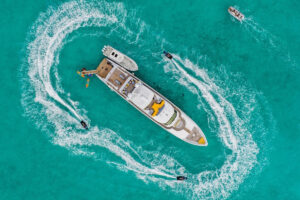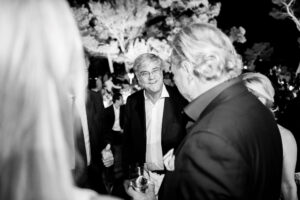During the mid-1800s, Sarasota was a beach frontier on the west coast of Florida, populated by a handful of fishermen, some cow hunters and a few determined settlers from the north. Its streets were paths of sand. A typical cracker shanty had no stove, lamp or candles, only a stick-and-mud fireplace on the floor of sand.
Thick clouds of mosquitoes, biting flies and gnats at times made life intolerable, and yellow fever always threatened. Wild Spanish cattle and razorback hogs roamed freely into the settlements, munching weeds that grew close to the homes and around the chicken coops. Torrential rains swept through from the east every summer afternoon, as they do today. At night, after the cooling rains moved out over the Gulf of Mexico and the breeze relaxed to humid stillness, the shrieks of panthers filled the steamy cabbage palm thickets and wolves howled at the moon. The mournful calls of whippoorwills echoed across the bay, which glowed with the green phosphorescence of feeding fish.
A mere century and a half later, Sarasota earned fame as one of the finest places in the United States to live. It’s also a wonderful destination for yachtsmen. One visit will tell you why.
A chain of slender barrier islands-Longboat, Lido, Siesta, Casey and St. Armand’s keys-creates nearly 150 miles of waterfront on the Gulf of Mexico and is home to several yacht clubs, 20 marinas and many fine restaurants. The tropical climate is soft and nurturing at least nine months of the year, but can be sweltering in summer.
Centuries ago, a limitless supply of wildlife drew settlers to these shores. Fishing remains one of the area’s greatest attractions, as it likely was in the 1800s, when an Army officer wrote, “The water appeared alive with multitudes of fish of every kind and little exertion was required to net as many as we wished. Seafowl lined the beach, shown brilliantly in the sun from the red plumage of the flamingos and pink curlew. Our hunters returned in the evening with two fine deer… sharks were very numerous here, actually swimming about in schools. Any quantity of shellfish was to be had.”
How Sarasota got its name is unclear. Conflicting stories say it came from the Spanish term sarao sota, meaning “a place of dancing.” Other stories say Hernando de Soto named the area for his daughter, Sara. The name first shows up on old Spanish maps as Zarazote.
Although the Spanish were the first to explore the area that’s now Sarasota, the city and islands nearby owe a great deal of their present-day character to a handful of individuals.
William Whitaker and Hamlin Snell were the first permanent settlers. In 1843, they rafted together cedar logs, floated across the bay from Longboat Key and set up housekeeping across the bayou from longtime resident fishermen Manuel Olivella and José Elzuardi. This “land rush” caused Olivella to file a land claim in 1843. Although Whitaker and Snell herded wild cattle, they also were the first to plant orange groves in Sarasota, and they introduced the guava to the United States.
Land developers discovered Sarasota near the turn of the 19th century. The Florida Mortgage Investment Company purchased 60,000 acres and appointed as manager Scotsman Capt. J. Hamilton Gillespie, son of the syndicate leader. Gillespie, an avid golfer, pitched his tent at the northernmost point of Sarasota Bay and chopped a two-hole golf course out of the surrounding jungle. He then built a large hotel and commissary for visiting sportsmen and tried to persuade immigrating Scotsmen to ignore the mosquitoes and buy lots from Florida Mortgage. Today, Sarasota and the surrounding areas in Manatee and Sarasota counties contain about 50 golf courses.
By 1911, the railroad ushered Sarasota into the modern era. John Ringling, a founder of the Ringling Bros. and Barnum & Bailey Circus, began his new bay-front mansion, which he modeled after the Doge’s Palace in Venice, Italy. He built an adjoining art museum to house his world-class collection.
As the population of Sarasota soared during the Roaring ’20s, Ringling poured all his resources into developing the mainland and barrier islands. He built a wooden causeway connecting Longboat and St. Armand’s keys with the mainland, dredged to fill in the mangrove fringes, installed sewer and water systems, built roads, and planted palm and banyan trees. His work and enthusiasm set the standard for the culture and general quality of life.
Ringling’s devotion to the arts helped establish Sarasota as the “Arts Capital of Florida.” The city is home to the Florida West Coast Symphony, Sarasota Ballet, Asolo Performing Arts Theater, Sarasota Opera House, Ringling School of Art and Van Wezel Performing Arts Hall, designed by Frank Lloyd Wright.
After World War II, a second wave of settlers emerged. Among these northerners were a host of artists and writers. Most chose to live on Siesta Key and gathered regularly at a local watering hole, the Beach Club, to debate art and politics.
In one get-together, artist Ben Stahl and authors Mackinlay Kantor and John D. MacDonald debated the theory that painters could write but writers couldn’t paint. They made a bet, which sent Stahl to his studio to write “Blackbeard’s Ghost.” The book was an artistic success, and Walt Disney made a movie based on the story.
Money magazine recently rated Sarasota one of the most attractive places in the United States to live. The majority of Sarasota’s residents have the wealth to live anywhere in the world, but they’ve chosen Sarasota.
It’s no wonder why.
NAVIGATING SARASOTA
Access to Sarasota by boat is easy. However, exercise caution from the Gulf of Mexico through New Pass or Big Sarasota Pass.
Along the Intracoastal, heavy winds during strong winter cold fronts tend to blow out more water than usual. At low tide, depths are less than 9 feet in some spots. On average, the bays outside the channels can’t carry more than 6 feet.
The safest heading for larger vessels from the south is to leave the Gulf through Venice Inlet and link up with the waterway. From Fl R 6s BELL R “2” at Boca Grande Pass, the distance to Venice Inlet at Fl G 6s 20ft 9M “1” is about 27.6 nm on a course of 347 magnetic. To Big Sarasota Pass is 10.4 nm on a course of 330 magnetic to Fl G 4s G “1.”
New Pass takes you directly into Sarasota Bay. To avoid shallows, approach Fl R 4s BELL R “2” from the southwest. Watch for strong currents and be prepared for the 23-foot bascule bridge, which opens every 20 minutes from 7 a.m. to 6 p.m.
From the north, enter at the northern tip of Anna Maria Island into Tampa Bay, then head south. Large boats should not enter here.
Marinas
Marina Jack, (941) 955-9488, has 10 transient moorings/berths, 130 LOA max.
Longboat Key Moorings, (800) 858-0836, has 20 transient moorings/berths, 150 feet LOA max.







